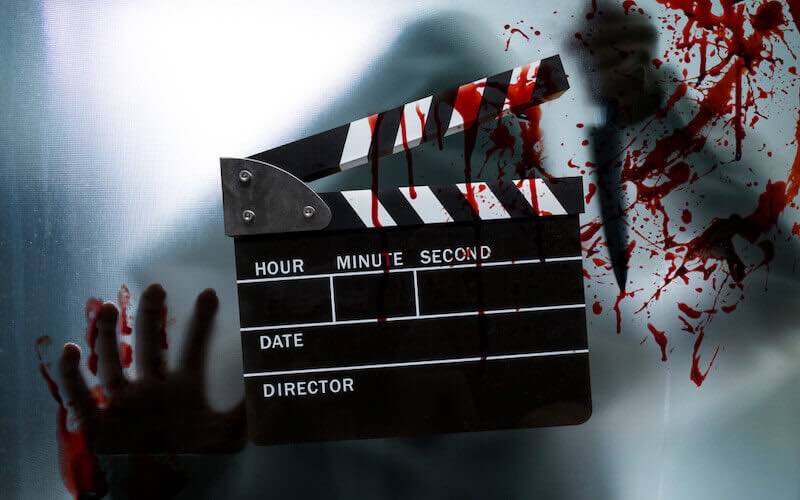
Movies you didn’t know were based on books: Halloween edition
In this blog:
- The Shining
- Psycho
- The Silence of the Lambs
- Hellraiser
- The Thing
- The Exorcist
- Jaws
- The Haunting
- I Am Legend
- The Ring
The Shining (1980) – Based on Stephen King’s The Shining
Stanley Kubrick’s cinematic masterpiece, The Shining, is often revered as one of the greatest horror movies ever created, but the plot originally sprang from the dark and twisted mind of Stephen King.
Published in 1977, King’s novel, The Shining, is a chilling exploration of isolation and supernatural dread. While the film, although iconic, takes several creative departures from the source material, both renditions are cherished in their own unique ways.
In King’s novel, his storytelling prowess truly shines, offering a deeper plunge into the psychological torment of Jack Torrance and the eerie Overlook Hotel. If you’re a fan of the movie, it’s well worth giving Stephen King’s book a shot – you might even discover that the book surpasses the film!
Psycho (1960) – Based on Robert Bloch’s Psycho
Alfred Hitchcock’s Psycho is an iconic thriller, but you might be surprised to know that it originated from the pages of Robert Bloch’s novel.
Published in 1959, Bloch’s book served as the unsettling source material for the world of Norman Bates and his infamous Bates Motel. Notably, the film’s famous shower scene was directly influenced by Bloch’s suspenseful storytelling.
While Hitchcock’s adaptation became a classic in its own right, Bloch’s novel explores the twisted psyche of the Bates family even further than Hitchcock’s silver screen adaption does.
The Silence of the Lambs (1991) – Based on Thomas Harris’s The Silence of the Lambs
The Silence of the Lambs is a spine-tingling crime-thriller that has kept audiences on the edge of their seats for years, but it all started with Thomas Harris’s equally chilling novel.
Certainly, here’s a different version of the copy tailored for a US audience:
“Published in 1988, Harris’s novel introduced us to the brilliant yet disturbed Dr. Hannibal Lecter and the determined FBI trainee Clarice Starling. Jonathan Demme’s film adaptation brought these characters to life, featuring unforgettable performances by Jodie Foster and Anthony Hopkins.
The movie is widely acclaimed for its suspense and psychological depth, while Harris’s novel is particularly renowned for its unconventional ending. If you’re a fan of the movie, consider reading the book to see how it compares!
Hellraiser (1987) – Based on Clive Barker’s The Hellbound Heart
It might surprise you to know that the nightmarish world of Hellraiser originated from the twisted imagination of Clive Barker. This iconic horror flick is actually based on Barker’s novella, The Hellbound Heart.
In both the book and the movie, Barker crafts a dark and unsettling tale of desire, pain, and the horrifying consequences that unfold when one ventures into the realm of the Cenobites.
While the film is well-known for its gruesome special effects and chilling atmosphere, the novella is equally brilliant. It delves even deeper into The Labyrinth (otherwise known as Hell) and the Lament Configuration. For horror enthusiasts looking to uncover the origins of this hellish masterpiece, the novella is a must-read.
The Thing (1982) – Based on John W. Campbell Jr.’s Who Goes There
John Carpenter’s The Thing is a classic in the world of sci-fi horror, but its origins trace back to a novella by John W. Campbell Jr. called Who Goes There?
Originally published in 1938, Campbell’s story laid the foundation for the gripping narrative of the movie. Both the novella and the movie revolve around a research team stationed in the Antarctic who cross paths with a shape-shifting alien creature capable of mimicking any living being, sparking paranoia and mistrust among the group.
Campbell’s original work explores themes of fear, isolation, and the mysteries of the unknown within a concise novella. On the other hand, Carpenter’s adaptation brought these themes to life through stunning special effects and makeup, leaving an indelible mark on the genre.
The Exorcist (1973) – Based on William Peter Blatty’s The Exorcist
Regan’s chilling possession in The Exorcist has become an unforgettable image in the realm of horror, but did you know that it all began with William Peter Blatty’s novel?
First published in 1971, Blatty’s book skillfully crafts a narrative of demonic possession and the epic struggle between good and evil. The film adaptation, helmed by director William Friedkin, both shocked and horrified audiences with its vivid and intense portrayal of the possession.
While the movie is acclaimed for its startling visuals and eerie atmosphere, Blatty’s novel delves even deeper into themes of faith, doubt, and the supernatural, offering a truly haunting perspective.
Jaws (1975) – Based on Peter Benchley’s Jaws
Steven Spielberg’s iconic summer thriller, Jaws, is a cornerstone of the horror genre, but its roots can be traced back to Peter Benchley’s novel with the same title.
Published in 1974, Benchley’s book introduced readers to the menacing great white shark wreaking havoc on the fictional town of Amity Island. Spielberg’s adaptation brought Benchley’s suspenseful story to the silver screen with heart-pounding tension and unforgettable shark attacks.
While the film is renowned for its suspenseful music, thrilling action sequences, and, of course, the astonishingly realistic animatronic shark used during filming, Benchley’s novel provides a slightly different perspective, focusing on the characters’ distinct personalities and delving into their fears and the economic pressures of a small beach town.
The Haunting (1963) – Based on Shirley Jackson’s The Haunting of Hill House
Before the hit Netflix series adaptation, Robert Wise’s timeless horror masterpiece, The Haunting, drew its inspiration from Shirley Jackson’s chilling novel, The Haunting of Hill House.
Originally published in 1959, Jackson’s book served as the creative foundation for the film’s hair-raising atmosphere and supernatural occurrences. The narrative revolves around a group of individuals invited to a mansion rumored to be haunted, where they confront terrifying and unexplainable events.
Wise’s adaptation is lauded for its eerie ambiance and psychological horror, yet Jackson’s novel delves even further into the psychological torment experienced by its characters, solidifying its enduring legacy in the realm of horror.
I Am Legend (2007) – Based on Richard Matheson’s I Am Legend
Will Smith’s gripping post-apocalyptic thriller, I Am Legend, actually finds its origins in Richard Matheson’s 1954 novel of the same name. Matheson’s novel, also titled I Am Legend, provides a unique perspective on the story, exploring the psychological toll of being the last surviving human in a world overrun by vampires.
While the film is often celebrated for Will Smith’s compelling performance and its action-packed sequences, Matheson’s exploration of isolation and the struggle for survival against bloodthirsty creatures makes it essential reading for any fan of the movie.
If you’re a fan of I Am Legend and have a love of vampire-themed stories, Matheson’s book is sure to captivate you!
The Ring (2002) – Based on Koji Suzuki’s Ringu
After watching The Ring, you’ll never look at a videotape the same way again. But did you know that this terrifying tale originated from a Japanese novel? The movie, directed by Gore Verbinski, is a chilling adaptation of Koji Suzuki’s novel, Ringu.
First published in 1991, Suzuki’s book introduced readers to the cursed videotape and the vengeful spirit of Sadako. The Ring takes this premise and transforms it into a hair-raising cinematic experience that captivated audiences worldwide.
The film, including the Japanese version Ringu, is renowned for its heart-stopping jump scares. In contrast, Suzuki’s novel delves deeper into the supernatural mysteries surrounding the cursed video, making it essential reading for horror enthusiasts eager to uncover the roots of this iconic franchise.
Next time you watch these spine-tingling Halloween classics, remember that their roots trace back to the pages of books! If you prefer watching movies instead, get your Halloween essentials cheaper when you buy second-hand DVDs from Decluttr.


 Sign In
Sign In
 Support
Support
 Start Selling
Start Selling





